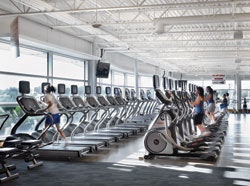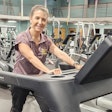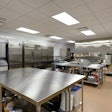Low tech still rules in sustainable rec center design, but the time seems ripe for certain innovations to begin infiltrating the market.
 Photo of people working out in a recreation center
Photo of people working out in a recreation centerSustainability is, for want of a better word, hot. Renewable energy in particular - harnessing the abundant energy of the sun, wind, planetary core, rivers and oceans to heat, cool and light our homes and businesses - is more than ever exciting the popular imagination and attracting economic incentives to spur its development.
The engineering that supports and delivers all that good work, on the other hand, isn't sexy. Pumps, chillers, ducts, switches, wiring and ballasts are tools of the mechanical and electrical trades, operating with mundane efficiency almost entirely out of our view. Yet, they're vital to our buildings' health, by regulating the temperature and allowing us to see. In organic terms, they're our recreation centers' circulatory and central nervous systems.
Even with all the attention paid to emerging technologies, making buildings more energy efficient is still mostly a matter of tinkering with familiar types of equipment to make them run better - minor surgery, as it were. But as private and government money flows into the field, more advanced green technologies have the potential to - eventually, as costs decrease - transform buildings of all types.
Although building system innovations are popping up in homes and office buildings, many people in the field of sustainable design characterize bells and whistles as secondary to building architecture basics such as insulation and solar orientation. Mark Gelfo, a sustainability consultant with TLC Engineering for Architecture in Jacksonville, Fla., is one who holds firm in his belief that the old is as vital to green design as the new.
"Sustainable buildings can blend really low tech and really high tech, and they don't look much different than regular buildings," Gelfo says. "Making a building sustainable is sometimes about taking advantage of the latest whiz-bang, newfangled stuff, but usually it's just about applying very common technologies in a smart manner, and trying to take advantage of the synergies of different systems."
Certain technologies combine the common and newfangled - or perhaps it is more accurate to say that older technology is continually being improved. Roger Hedrick, team leader in building analysis and a senior engineer with Boulder, Colo.-based Architectural Energy Corporation, holds up condensing gas boilers (used in central heating systems) as Exhibit A. The advantage of condensing gas boilers lies in the way they utilize the residual heat generated from combustion; they extract additional heat from waste gases by condensing the steam produced into liquid, thus recovering its latent heat. "The technology, which has been around for quite a while, allows the units to get into the 90 to 95 percent efficient range," Hedrick says. "They are especially advantageous in new construction, as they allow costs to be cut in venting, and the difference in price between condensing units and conventional units is not as high as it used to be." On the cooling side, Hedrick notes that equipment is becoming more efficient simply by making heat exchange coils larger, or by making small improvements to motors and compressors.
Another good example is the energy management system, which refers to the heating, ventilating and lighting control portion of what since the 1970s has been referred to as either a building automation system or building management system. Building automation systems, which have traditionally been put in place in larger structures (or groups of structures, such as on a college campus), monitor utility meters, control life-safety functions such as security, fire alarm and elevator systems, and offer computerized control of the building environment - primarily air flow, temperature and humidity. They also collect usage data to allow building owners to track trends and locate potential areas of usage reduction, and now also display real-time consumption information in an effort to prompt conservation among all building occupants. One study showed that placing energy meters in people's homes led to a 7 percent reduction in consumption; one researcher has dubbed this the "Prius Effect," because hybrid drivers have demonstrated that seeing real-time consumption data has an effect on driving technique.
Using the building automation system to monitor the level of human-generated carbon dioxide levels is, similarly, not a new concept, but improvements to the reliability and accuracy of CO2 sensors has allowed this older technology to be used much more effectively over the past several years. Known as demand-control ventilation, the strategy involves responding to CO2 increases as building occupancy rises by automatically mixing in outside air with waste air, meaning that air exchanges don't occur unnecessarily when a space is not in full use. Although at first glance it seems like a high-tech concept, Gelfo notes that the CO2 sensor is a "fairly common instrument, not dissimilar from a thermostat" - and it will soon be standard practice in the same way that motion sensors are used to control the use of artificial lighting.
Because HVAC, lighting and other systems linked to building automation systems typically represent 70 percent of a building's energy usage - indeed, improperly configured systems are said to account for 8 percent of all energy usage in the United States - the market for automated systems is in a period of vigorous growth. Davis Watkins, vice president of commercial sales with San Diego-based Advanced Telemetry, maker of EcoViewâ¢, says advances in wireless network technologies have brought affordable systems within the reach of smaller commercial building owners. A wireless system can be installed in less than half a day, and offers the added benefit of remote monitoring and control of any circuits linked to it. (Lighting systems are being made more efficient with the advent of IP-addressable ballasts, which allow finer control, from any location, of illumination levels throughout a space.)
The boost in building automation sophistication sends up at least one red flag for Gelfo. "We go back into buildings a lot of times and see that the really high-tech control system that we put together isn't being used because the operator didn't understand it, so they've overridden everything and are running the building at full AC 24 hours a day," he says. "So, one of the keys is to work with the operations staff to determine what their capabilities are and how they want to operate the system. It's better to design the system and controls to meet their capabilities, rather than just sell them the new coolest thing."
Hedrick approaches energy management systems with a firm belief in their applicability, but has a caveat of his own. "I do lots of energy modeling, and it's not something we incorporate into our models very often, because we can't quantify how much benefit we're going to get from an energy management system," Hedrick says. "That said, they're efficient because they make sure you're supplying what you need where you need it, and not somewhere else. Digital control systems allow for more advanced control strategies - they do save energy."
A significant advance in air-handling systems represents, again, a relatively small change to an established technology. Total energy recovery wheels are similar to their predecessors, heat recovery wheels, in that they facilitate the air-to-air transfer of heat; the difference is that the new systems also capture and reuse latent heat from humidity or occupants' breath or perspiration in the air. Rotating slowly within the air-handling system's supply air stream and exhaust air stream, the desiccant-impregnated wheel absorbs moisture from one air stream and transfers it to the other, reducing heating and cooling costs.
"If it's hot and humid, the outgoing air stream is pretty cool and dry in comparison, so that is used to dehumidify the incoming air stream," explains Mike Walters, sustainability practice leader with AEI Affiliated Engineers of Madison, Wis. "In the middle of the winter, the wheel uses the relatively warm air that you're exhausting to warm the fresh air before it's supplied to the space. They're becoming more prevalent in laboratory and healthcare buildings because of those types of facilities' high air-exchange requirements, and they've shown to be about 85 percent effective at recovering energy from one air stream to the other."
While the applicability of most sustainability innovations isn't a question, their payback sometimes is. Total energy recovery wheels appear to fare well on this score. HGA Architects & Engineers of Minneapolis estimates that the total energy recovery wheel (and other sustainable lighting features) it specified for Leonard A. Ford Hall, a 67,000-square-foot addition to Mankato State University's Trafton Science Center, added nearly $1 million to the total project cost - an investment it will recover through energy savings in about four and a half years.
As Walters considers the costs and savings associated with various technologies, he invariably steers away from the Big Environmental Statement (photovoltaic panels) and comes back, instead, to the less overtly cool.
"A heat pump chiller has a much quicker payback," he says. "It's nothing sexy; you're never going to see it. It's a typical heat pump but it's capable of making both hot and cold air at the same time, so you can be very efficient from both a heating and a cooling perspective. But it's tough to get people excited about."




































